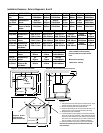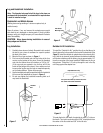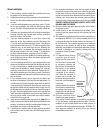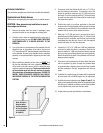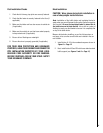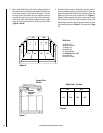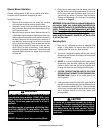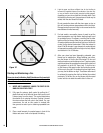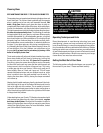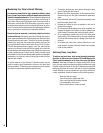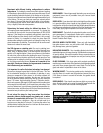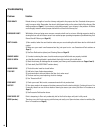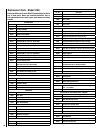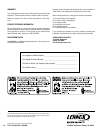
15
Operating Techniques and Hints
Recent developments in wood-burning technology have made
wood-burning a cleaner and more convenient way to heat your
home. Overall efficiency in a wood-burning appliance is a combina-
tion of combustion efficiency and heat transfer efficiency. Whether
heating your entire home, or just a room or two, your understanding
of how to best operate your stove or insert will enhance its overall
efficiency and performance. What this can mean to you is longer,
cleaner burns, less wood use and more heat.
Getting the Most Out of Your Stove
The following sections will outline techniques you can use to “get
the most out of your stove.” Please read them carefully.
Cleaning Glass
SEE MAINTENANCE ON PAGE 17 FOR GLASS CLEANING TIPS
The operator plays an important part in keeping the glass clean and
free of build-ups. The first and most important part the operator
plays is making sure to burn only well-seasoned firewood. Wet
wood = Dirty glass. Keeping your glass door clean is partly ac-
complished by the air wash system of the stove, which sends clean,
fresh air for combustion, over the window before it enters the fire.
The high temperatures inside the firebox also keep the glass clean.
No stove door stays perfectly clean. The following are methods
for keeping build-up on your glass to a minimum. When properly
installed and operated by a knowledgeable operator, your glass
door should require very little maintenance. Do not expect to get
extremely long burn times and keep the window perfectly clean.
Cool temperatures cause condensation of unburned volatiles on
the glass. If your glass gets very dirty during overnight burning,
try preheating the stove a little longer before damping it down for
an overnight burn. Also, don’t damper your stove down as low
because you’ll get more heat for your money by burning a little
hotter for a slightly shorter time.
The air wash system will perform at its best at medium burn rates.
Some stove models will self clean by burning very hot fires but
be sure not to over-fire the stove. If it glows red it is over-fired.
Over-firing a stove also causes the window to soot up. Extremely
hot fires with fresh wood may cause the flow rate to exceed one
foot per second, which is as fast as a flame can burn. This is why
a candle goes out when you blow on it. Blow on it gently and it
burns brightly. Blow on it hard and it goes out. This will cause
excessive exhaust emissions and your window to soot up, as the
stove is unable to burn the gases emitted from the wood. Try
slowing the stove down a little by closing the damper somewhat
as it warms up.
Keeping freshly loaded wood away from the window will also help.
Load fresh logs in the rear of the firebox. Build-up tends to occur
first on the right side of the window. This is caused by the swirl-
ing motion of the exhaust gases similar to water running down a
drain. Keep fresh logs further back on the right side of the firebox
to help prevent this problem.
Understanding how your Country™ Collection stove works should
help you keep your glass door very clean, but as stated: no glass
door stays perfectly clean. We hope this information is helpful in
keeping your glass door clean so that you may enjoy many hours
viewing your high efficiency stove. For more information, contact
your Lennox Hearth Products dealer.
CAUTION
Cleaning Glass: Ensure appliance is cold prior
to cleaning glass. A commercial glass cleaner
designed for stoves is recommended. Do not use
abrasive cleaners. Do not clean with any materials,
which may scratch or otherwise damage the glass.
Scratches on the glass can develop into cracks or
break. Inspect the glass regularly. If you detect a
crack, extinguish the fire and contact your dealer
for a replacement.



